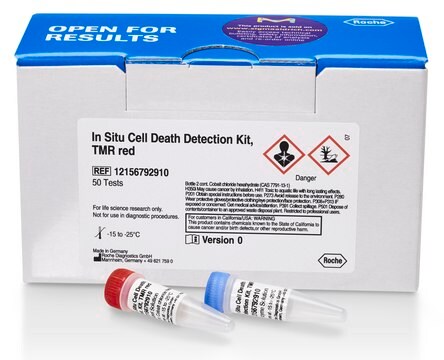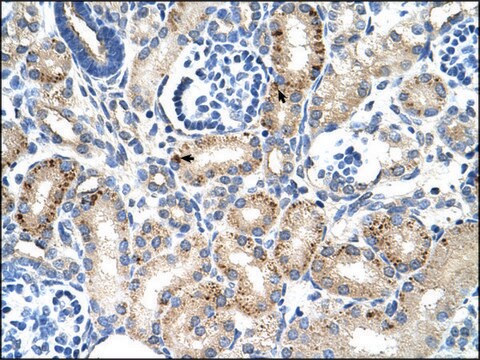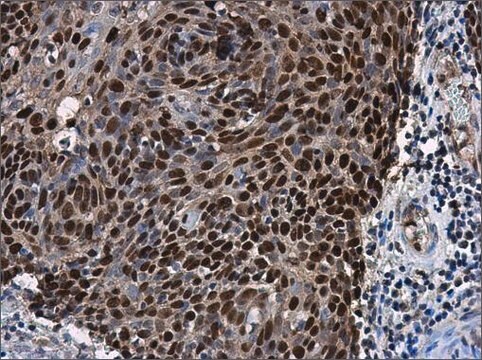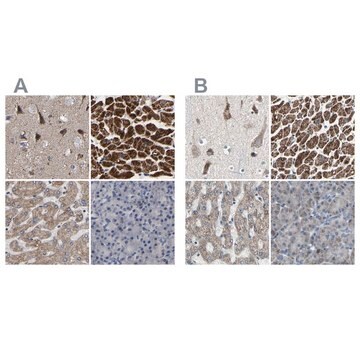推薦產品
生物源
rabbit
品質等級
共軛
unconjugated
抗體表格
affinity isolated antibody
抗體產品種類
primary antibodies
無性繁殖
polyclonal
產品線
Prestige Antibodies® Powered by Atlas Antibodies
形狀
buffered aqueous glycerol solution
物種活性
human, rat, mouse
技術
immunoblotting: 0.04-0.4 μg/mL
immunohistochemistry: 1:20-1:50
免疫原序列
LFRFMNFLKQEGAVHVLQFCLTVEEFNDRILRPELSNDEMLSLHEELQKIYKTYCLDESIDKIRFDPFIVEEIQRIAEGPYIDVVKLQTMRCLFEAYEHVLSLLENVFTPMFCHSDEYFRQLLRGAESPTRN
UniProt登錄號
運輸包裝
wet ice
儲存溫度
−20°C
目標翻譯後修改
unmodified
基因資訊
human ... SNX14(57231)
免疫原
Sorting nexin-14 recombinant protein epitope signature tag (PrEST)
應用
Applications in which this antibody has been used successfully, and the associated peer-reviewed papers, are given below.
Immunofluorescence (1 paper)
Western Blotting (1 paper)
Immunofluorescence (1 paper)
Western Blotting (1 paper)
特點和優勢
Prestige Antibodies® are highly characterized and extensively validated antibodies with the added benefit of all available characterization data for each target being accessible via the Human Protein Atlas portal linked just below the product name at the top of this page. The uniqueness and low cross-reactivity of the Prestige Antibodies® to other proteins are due to a thorough selection of antigen regions, affinity purification, and stringent selection. Prestige antigen controls are available for every corresponding Prestige Antibody and can be found in the linkage section.
Every Prestige Antibody is tested in the following ways:
Every Prestige Antibody is tested in the following ways:
- IHC tissue array of 44 normal human tissues and 20 of the most common cancer type tissues.
- Protein array of 364 human recombinant protein fragments.
聯結
Corresponding Antigen APREST72879
外觀
Solution in phosphate-buffered saline, pH 7.2, containing 40% glycerol and 0.02% sodium azide
法律資訊
Prestige Antibodies is a registered trademark of Merck KGaA, Darmstadt, Germany
免責聲明
Unless otherwise stated in our catalog or other company documentation accompanying the product(s), our products are intended for research use only and are not to be used for any other purpose, which includes but is not limited to, unauthorized commercial uses, in vitro diagnostic uses, ex vivo or in vivo therapeutic uses or any type of consumption or application to humans or animals.
未找到適合的產品?
試用我們的產品選擇工具.
儲存類別代碼
10 - Combustible liquids
水污染物質分類(WGK)
WGK 1
閃點(°F)
Not applicable
閃點(°C)
Not applicable
個人防護裝備
Eyeshields, Gloves, multi-purpose combination respirator cartridge (US)
分析證明 (COA)
輸入產品批次/批號來搜索 分析證明 (COA)。在產品’s標籤上找到批次和批號,寫有 ‘Lot’或‘Batch’.。
Joe Fenn et al.
BMC genetics, 17(1), 123-123 (2016-08-28)
Cerebellar cortical degeneration (CCD) is an increasingly recognised neurodegenerative disease process affecting many dog breeds. Typical presentation consists of a progressive cerebellar ataxia, with a variable age at onset and rate of progression between different breeds. Cerebellar histopathological findings typically
Dale Bryant et al.
Scientific reports, 10(1), 13763-13763 (2020-08-15)
Mutations in the SNX14 gene cause spinocerebellar ataxia, autosomal recessive 20 (SCAR20) in both humans and dogs. Studies implicating the phenotypic consequences of SNX14 mutations to be consequences of subcellular disruption to autophagy and lipid metabolism have been limited to
Hsien-Sung Huang et al.
PloS one, 9(5), e98383-e98383 (2014-05-27)
Genomic imprinting describes an epigenetic process through which genes can be expressed in a parent-of-origin-specific manner. The monoallelic expression of imprinted genes renders them particularly susceptible to disease causing mutations. A large proportion of imprinted genes are expressed in the
Sanchari Datta et al.
The Journal of cell biology, 218(4), 1335-1351 (2019-02-16)
Lipid droplets (LDs) are nutrient reservoirs used by cells to maintain homeostasis. Nascent droplets form on the endoplasmic reticulum (ER) and grow following an influx of exogenous fatty acids (FAs). The budding of LDs requires extensive ER-LD crosstalk, but how
Snx14 regulates neuronal excitability, promotes synaptic transmission, and is imprinted in the brain of mice.
Huang HS, Yoon BJ, Brooks S, et al.
PLoS ONE, 9(5), e98383-e98383 (2014)
我們的科學家團隊在所有研究領域都有豐富的經驗,包括生命科學、材料科學、化學合成、色譜、分析等.
聯絡技術服務







